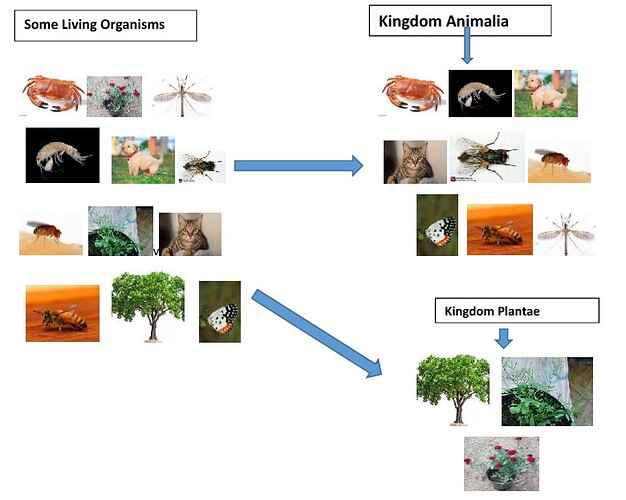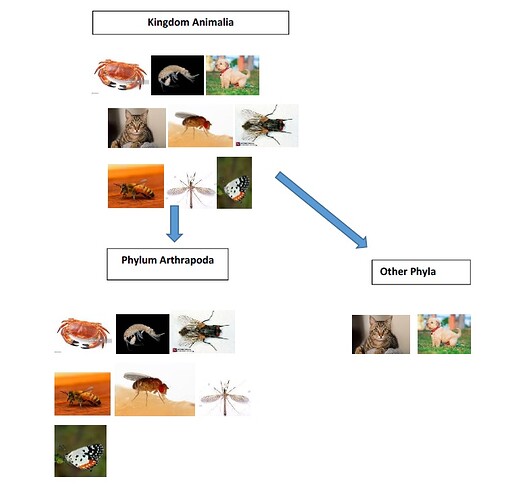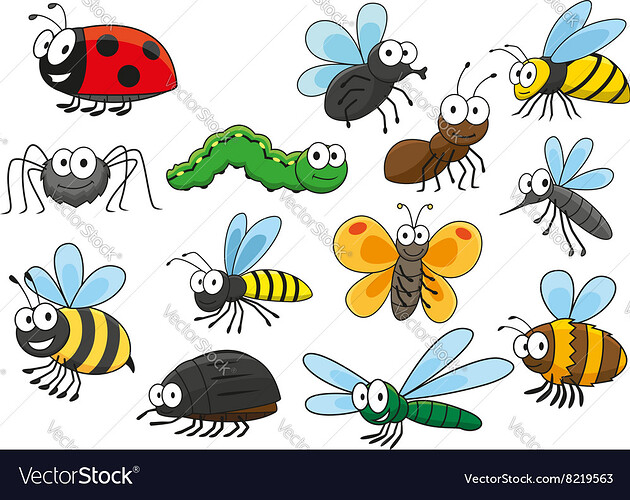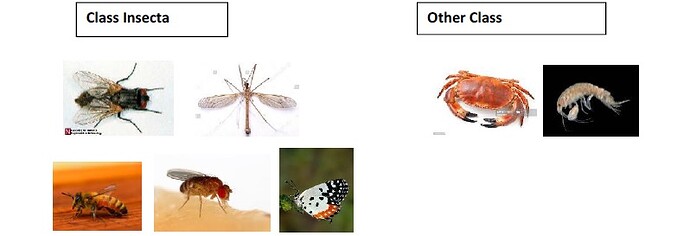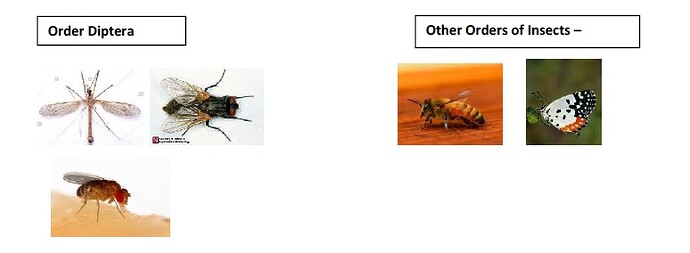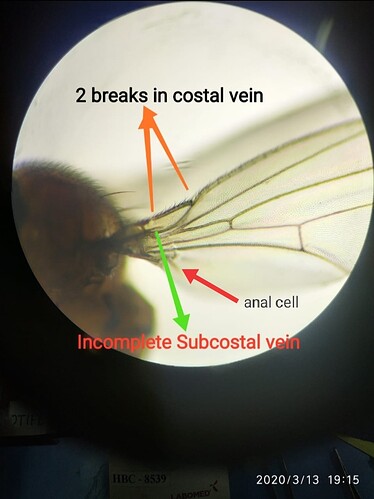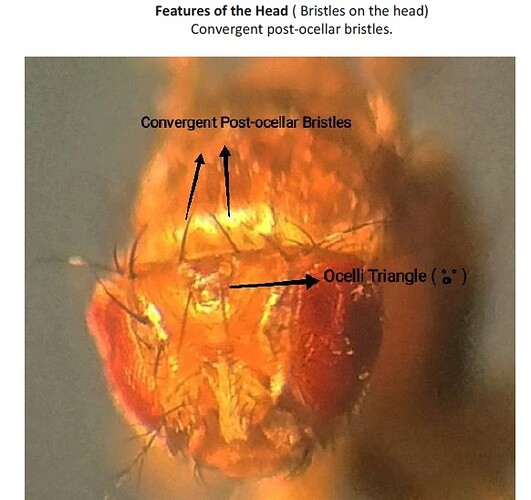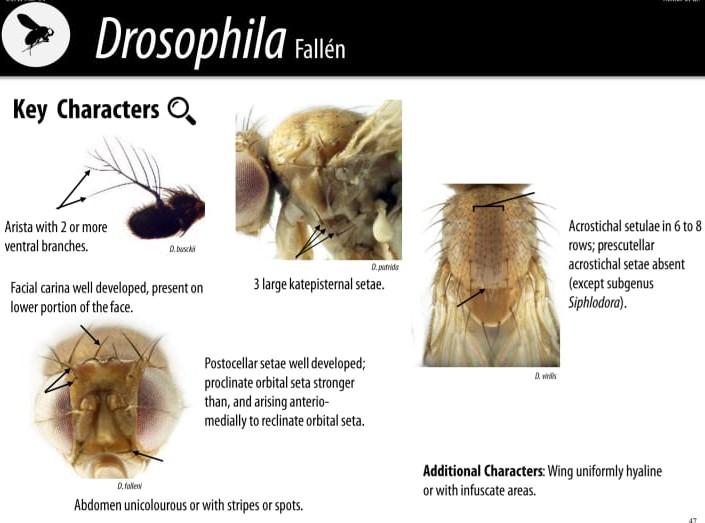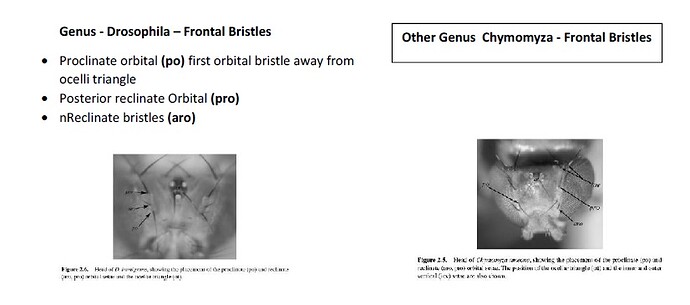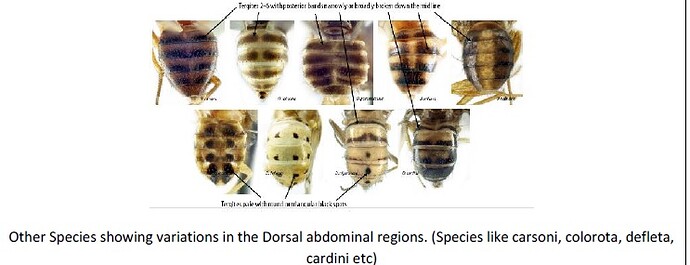Identification and Classification can be simply put to say as something that helps us put living organisms into similar or different groups.
[size=5 ]Let’s take a simple yet classic example[/size]
Just as how Book Libraries have various sections like Science Fiction, Non-Fiction, Comedy, Economics, and so on. Imagine a Book Library where all Different Books are kept together in shelfs. How Difficult would it to Find your Harry Potter book series amongst all the 1000 books in a SINGLE shelf?!
And thats how important it is to classify organisms. Why? Or else how would we appreciate and call upon what is what?
As you see our [size=4]objective[/size] here is to simplify what we study in school which is known as
-
Classification and Identification of Living life and more specifically
-
To learn together on How do we Classify Organisms systematically!
-
Classify our Nobel Prize winners - Fruit flies and Identify the main hero amongst different types of fruit flies seen in nature – one amongst them is the Nobel Prize winner ‘Drosophila melanogaster’.
Lets Begin together !
There is a large number of living organisms found on the earth. All these organisms show variations in their shape, size, structure, body parts, habit, habitat, nutrition, etc
[size=7] ![]()
![]()
![]()
![]()
![]()
![]()
![]()
![]()
![]()
![]()
![]()
![]()
![]()
![]() [/size]
[/size]
[size=4]What do Dogs, Cats, (your favourite pet probably), Plants at your home or garden, mosquitoes, butterflies, fruit flies, Houseflies, birds, honeybees, prawns, fishes and even lions all have in common[size=5]?[/size][/size]
Well to think very easily, all of them are Living Things or beings right? Different from probably our mobile phones or computers that we might be reading this blog from!
This is the aim of classification. To segregate and group organisms on the basis of various morphological (physical) characters!
The Science of Classification of living Organisms is referred to as Taxonomy. It is the science of naming, defining and classifying groups of biological organisms on the basis of shared characteristics.
The different levels of classification from larger range to small range of similarities and differences include
![]() Kingdom
Kingdom
![]() Phylum
Phylum
![]() Class
Class
![]() Order
Order
![]() Family
Family
![]() Genus
Genus
![]() and finally Species!
and finally Species!
Let’s pick other common organisms that we all are familiar with and look for what all physical characters to group certain organisms in same group and to exclude from the group of classification.
In the below picture, try to recognize all the living organisms placed in the left - Right from A Tree, Butterflies, cats & dogs, Crabs, prawns, honey bees, rose, house flies (BZzzzzz), mosquitoes and not to forget Fruit flies! ( ![]() )
)
Fruit flies belong to the Kingdom Animalia! (and Not Kingdom Plantae, Fungi ) This is because they exhibit the following characters that are mentioned below.
Fruit flies are multicellular and can move, walk and fly (are motile, unlike Kingdom Plantae and fungi), they feed on fruits and vegetables like banana, tomato, and even garbage waste.
[size=4]Kingdom Animalia Characteristics[/size] (https://en.wikipedia.org/wiki/Animal)
Animals have several characteristics that set them apart from other living things.
- Unlike plants and algae, which produce their own nutrients, animals are heterotrophic, feeding on organic material and digesting it internally.
- Animals are eukaryotic (have nucleus containing genetic material) and multicellular , unlike bacteria, which are prokaryotic (don’t have nucleus in and unlike protists which are eukaryotic but unicellular.
- All animals are motile . (they can move, crawl, walk, swim, run and fly etc.)
Lets move ahead will all the above Kingdom Animalia examples!
[size=4] How are fruit flies similar and Different to Butterflies, mosquitos, Honeybees, House flies, Crabs, Prawns?[/size]
And
[size=4] How are they different from other animals that we choose as an example from Kingdom Animalia? (Dogs and Cats?)[/size]
Next Division that helps us in grouping organisms include the ‘Phylum’ where fruit flies belong to the Phylum “Arthrapoda”
The word Arthropod literally means “Jointed leg” in Greek.
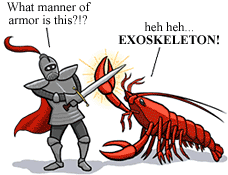
Phylum Arthrapoda Characteristics ([Arthropod - Wikipedia] [Arthropods](https://sites.google.com/site/p1arthropoda2013/main-page))
- An exoskeleton (outer covering like a shell or a polymer outer-coating)
- A segmented body (body divided into body parts)
- Paired jointed appendages. (jointed legs)
Looking at all the above characters, lets group our Kingdom Animalia - Animals?
Now that we have Arthropods together with our Nobel Prize winning Arthropod- Fruit fly
Who are all the other members with us?
Butterflies, Crabs, Honeybees, Houseflies, Mosquitoes and lastly Prawns.
Our Main question that we are using at each levels of Classification still somewhat remains the same.
How are now the other Members of Arthropods (Butterflies, Crabs, Honey bees, Houseflies, Mosquitos, Prawns) similar and Different from Fruit flies?
We reached now onto a next level of Classification which comes after Phylum.
The “CLASS”
[size=5]Fruit flies belong to the Class ‘Insecta’ (Keeda) and many other Arthropods too![/size]
LETS SEE HOW?
Class Insecta Characteristics (Insect - Wikipedia)
- Hexapod invertebrates. (‘Hexa’ meaning ‘6’ and poda means “Legs”)
- Chitinous exoskeleton.( Chitin, a type of polymer)
- Three-part body (head, thorax and abdomen).
- Three pairs of jointed legs.
- Compound eyes. (Compound eyes, something like 1000 lens forming an eye)
- One pair of antennae (Antennae, something like a Nose in Humans)
Fruit flies have a three-part body divided into Head, (head bearing the antennae and compound eyes) Thorax and Abdomen and they also have three pairs of jointed legs arising from separate thorax segments. These characters are also clearly visible in Other flies like Butterflies, Honey Bees, Mosquitoes but not in Crabs and Prawns.
The above picture now if observed carefully has all insects that are Flies.
(Yes because they have Wings to fly)
[size=4] Which makes it little more interesting to look at the following.
What do these flies (Fruit flies, Butterflies., Honey Bees, Mosquitos) have in common?
What are the morphological differences that will help us move forward to distinguish and identify Our Nobel Prize Winner – Drosophila melanogaster. (Fruit fly)[/size]
All the above mentioned flies have wings which make them fly! But Do you still find differences in the type of wings? (Not just the size and color but also the wing number)
[size=4]The next level of Classificaton that helps us group and differentiate between different insects is
The “ORDER”[/size]

Fruit flies have 2 wings ( a single pair) as-well as House flies & mosquitos and Hence they both Belong the Order Diptera (Di meaning ‘Two’ and Ptera meaning ‘Wing’) While Butterflies and Honey Bees have 4 wings (2 pair of wings) and hence belong to different Orders.
Order Diptera Characteristics ([Fly - Wikipedia] )([Dipteran | Definition, Life Cycle, Habitat, & Classification | Britannica)]
![]() di- “two”, and pteron “wing”
di- “two”, and pteron “wing”
![]() a single pair of wings
a single pair of wings
![]() Hindwings turn to halteres (pair of small club-shaped organs on the body- used for body rotations during flight).
Hindwings turn to halteres (pair of small club-shaped organs on the body- used for body rotations during flight).
Dipteran, (order Diptera), any member of an order of insects containing the two-winged.
Now that we have reached to differentiating Diptera flies (Fruit flies, Houseflies and Mosquitoes) from other flies (Butterflies and Honey Bees)
So the question comes down again to…
[size=4] How are fruit flies different from Houseflies and Mosquitoes?[/size]
[size=4]How do we differentitate between different types of fruit flies?[/size]
The next level of Classification that helps us differentiate between houseflies, fruit flies and Similarly Other Fruit flies different from Drosophila melanogaster include the Family Level of Classfication.
Lets take an example of a fruit fly that we all are familiar of, Drosophila melanogaster (CsBz - as you will get to know what is CsBz Drosophila melanogaster- to quickly tell- its a strain of Drosophila melanogaster originally maintained and identified by Seymour Benzer and collegaues.)
The Drosophilidae are a diverse, cosmopolitan family of flies, which includes fruit flies. Another unrelated family of flies, Tephritidae, also includes species known as “small fruit flies”
[size=5]The Fruit fly Drosophila melanogaster belongs to the Family Drosophilidae which is the Next Level of Classification![/size]
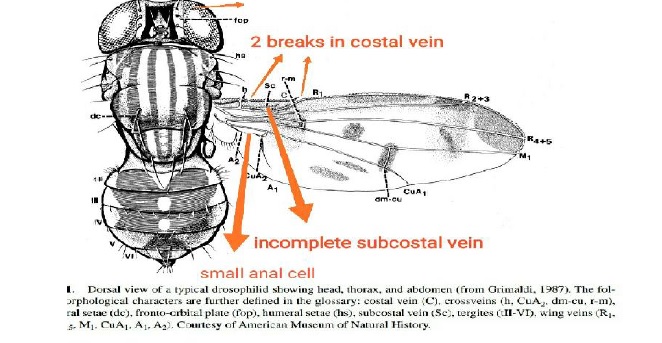
From the above picture, have a look at the wing structure. When you look at the wings, there are plenty of lines or vein like structures that will serve as the Structure that we will observe.
The different types of veins seen on the Wings include
a) Costal vein. (the top most vein from the thorax region)
b) Subcostal vein (small vein following the costal vein)
c) R1,R2+3,R4+5, M1,CuA1,A1 and A2. (Rest of the wing veins)
All this was to introduce to what are veins in the wings, just like we humans too have veins.(though they are different)
Fruit flies also referred to as Vineger flies are different from other fruit flies and definitely from Houseflies and mosquitoes.
[size=5]Family Drosophilidae Characteristics[/size]
[Drosophilidae - Wikipedia]
(PDF) Drosophila A Guide to Species Identification and Use | Mhmd El-zoghpy - Academia.edu
In case of Family Drosophilidae, one of the characters is
Features of Wing
-
- 2 Breaks in the Costal Vein.
-
- Incomplete Subcostal Vein.
-
- A small Anal Cell in wing.
[size=5]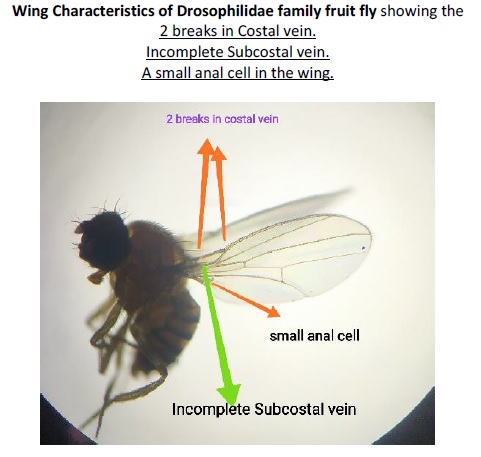 [/size]
[/size]
Features of the head
A pair of Convergent Postocellar bristles (Bristles are hair like structures while ocellar represents the ocellli triangle which could be said to be the third eye of Fruit flies!) see below)
Above two are Drosophilidae family fruit fly - Wing and Head features which are characteristically seen in only Fruit flies that belong to Family Drosophilidae and not in other flies like Houseflies, mosquitoes and even other family of fruit flies (Tephritidae)
The family Drosophilidae includes 73 extant and 3 extinct genera, encompassing over 3,950 species
So amongst the above diverse types of Genus and Species (Total 73 or more Genus and 3950 species we are Looking for Characteristics of the Genus Drosophila to continue with our objective of identifying Genus Drosophila and Species melanogaster
[size=4]Since there are so many genus under Drosophilidae family fruit flies, now we have to dive deep and look at simple yet detailed features of Genus Drosophila characters to help us differentiate from other 72 or more Genus[/size]
The DEVIL AND THE DIVINE IS SOMETIMES IN THE DETAILS!
[size=4]Genus Drosophila Characteristics[/size] (Genus Drosophila)
- Small yellow to brown flies.
- Body 2-6mm long.
- Facial carina well developed (including lower portion of face).
- Arista with 2 or more ventral branches.
- Postocellar setae well developed.
- Proclinate orbital seta stronger than and arising anterior to reclinate orbital seta.
- Mesonotum and pleuron unicolorous, or with stripes or spots.
- Proepisternal setae absent.
- 3 katepisternal setae.
- Achrostichal setulae in 6-8 rows.
- 2 pairs of dorsocentral setae.
- Prescutellar acrostichal setae absent.
- Wing uniformly hyaline or with infuscate areas.
- Abdomen unicolorous or with transverse bands or spots
Difficult? Lets make it easy with pictures!
[size=4]All General Characters of Genus Drosophila[/size]
[size=4]Genus Drosophila Head Bristle Features compared to Genus Chymomyza[/size]
[size=4]Genus Drosophila Thorax Bristle, setae and Setulae Features[/size] (all are different types of hairs)
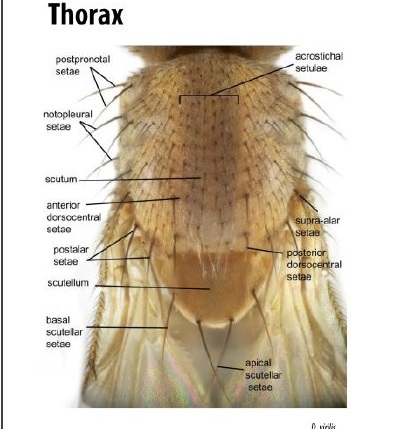
Isnt it cool, that the type and number and position of bristles,setae or setulae- the so called hairs on the different body parts of the fruit fly will help us Identify the Genus of Fruit flies?
Now that we have reached the Genus Drosophila, we need to ask for a few questions!
What are the diagnostic features of the Species Melanogaster amongst all the other Drosophila species!
The word melanogaster can be broken down to simple meanings - having a black belly(adjective section - melanogaster - Wiktionary, the free dictionary)
[size=5]Species - Drosophila melanogaster Characteristics[/size]
[(1- https://www.sciencedirect.com/topics/neuroscience/drosophila-melanogaster)]
[(2- https://cjai.biologicalsurvey.ca/mmg_31/mmg_31.pdf)]
[size=4]Following are the characteristics of the species melanogaster[/size]
The abdomen of Fruit flies has segments which differ in number and other features. The dorsal abdominal segment is referred to as ‘Tergite’ while the ventral abdominal segment is referred to as ‘Sternite’.
[left]1. * Abdominal Characteristics[/left]
-
Male melanogaster Species Abdominal Characteristics
-
Six Abdominal Tergites – number from 2 to 4 are pale yellow with narrow dark unbroken posterior bands,
-
Tergites number 5 and 6 completely Darkened.
-
Female melanogaster Species Abdominal Characteristics
-
Female tergites 2-6 pale yellow with narrow dark unbroken posterior bands.
Below Picture Showing melanogaster Species Tergites
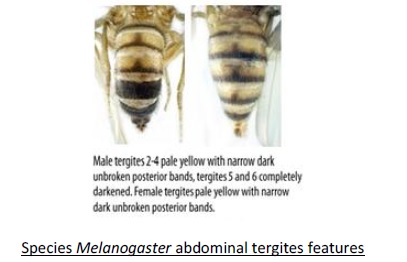
[left]2. Male Sex Comb Characters of Species melanogaster .[/left]
Male leg as a feature of Arthropod is a jointed leg which has three parts . A) Femur B) Tibia C) 5 Tarsal Segments.
Characteristic feature of Male Drosophila melanogaster species includes –a sex comb on the fore tarsus (1st segment of tarus) with 9-12 teeths.
Sex Comb Structure of Male Drosophila melanogaster species
[center][justify][size=4]Male Leg of Drosophila melanogaster showing different leg segments. The Fore tarsus in the left (bt) shows the sex comb and enlarged picture shows the number of Teeth on the sex comb (usually 9-12)[/size][/justify][/center]
Please have a look at all the references and cross references for each level of Classification to know better the individual characters.
Back to home page ![]()

